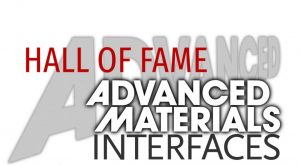Advanced Materials Interfaces began in 2014 as a forum for top-level research into interface and surface science. In this short time, it has already attracted many important, highly interdisciplinary contributions from recognized experts.

To build on this and to celebrate our 5th volume, we have initiated a series of invited-only review articles from the top scientists in the field: the AMI ‘Hall of Fame’. These articles will be collected into a very special virtual issue, and will be updated regularly as new contributions are published. All articles in the series will be made freely available to all for a limited time.
Keep an eye out for the ‘Hall of Fame’ logo on upcoming review articles, or bookmark the virtual issue page to stay on top of the latest critical works in this series.
In this monthly feature, we highlight the most recent papers which are published as part of Advanced Materials Interfaces “Hall of Fame”.
Role of Interface Interactions in the Construction of GO‐Based Artificial Nacres

By
Nacre‐inspired interfacial design strategies, including single interface interaction, synergistic interface interactions, and synergistic building blocks can assemble microscopic graphene nanosheets into macroscopic high‐performance multifunctional graphene‐based nanocomposites, including 1D fibers, 2D films, and 3D bulk materials.

By
The influence of interface on dielectric responses and breakdown strength in ceramics/polymer nanocomposites is analyzed and the viability of current interface engineering strategies in improving their energy storage capabilities is discussed. Interface modification leads not only to homogeneous dispersion of ceramic nanofillers, but also improves dielectric and energy storage performances in resultant nanocomposites from regulated local interfacial electrical and dielectric behaviors.

By ,
Origami and kirigami, ancient techniques for making paper artworks, enable many nontraditional, unusual applications in engineering and scientific fields. This review highlights the latest progress in the research on the origami and kirigami assembly of 3D structures in advanced materials at macroscale to microscale and nanoscale, focusing on assembly approaches at each length scale and/or the newly accessible unusual applications.
Low Work Function Surface Modifiers for Solution‐Processed Electronics: A Review

By Xiang Peng, Lin Hu, Fei Qin, Yinhua Zhou and Paul K. Chu
Low work function surfaces and interfaces are crucial to solution‐processed and printable optoelectronics, such as solar cells, light‐emitting diodes, transistors, and photodetectors. The mechanism, materials, device applications, and future outlook of solution‐processed low‐work function surface modifiers are reviewed.

















